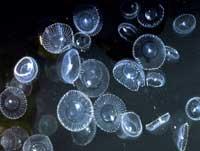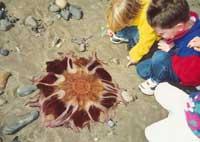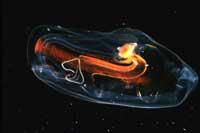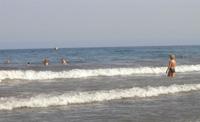Jellyfish, jelly thorns

The jellyfish arrive mainly to the beaches of Euskal Herria at the end of August and September. And they cause discomfort: some remain in the sand at low tide and those who walk along the shore have to avoid them at every step. Even swimming in the water is quite annoying: touching a tentacle is enough for the jellyfish to pinch the poison.
The puncture of the jellyfish is usually not severe, but painful. And it is that, although they are quite unknown in the rest, knows perfectly well that you have to be careful with jellyfish. However, not all jellyfish species are poisonous, at least for humans.
Here come the jellyfish
In all oceans there are jellyfish, both cold and temperate, and in the large freshwater lakes. There are many species of jellyfish. What usually reaches our shores is the Pelagia noctiluca, abundant in the Gulf of Bizkaia and, in general, in the Atlantic and in the Mediterranean.

Jellyfish live in the open sea. But they are not able to move by themselves, so the marine currents and, above all, the wind are pushed from one side to the other and thus reach the coast. The problem arises when jellyfish sets reach the beach. It is often heard that there is a “jellyfish plague” that annoys the human being. But that is to say more.
The jellyfish masses reach the beaches with the arrival of the seas, but not all, the open beaches are easier to reach and the orientation also has to do. In these beaches, in view of the large groups of jellyfish, you can think that this is a pest, but there is no data to secure it.
For example, it is said that at every medusa coming there are more jellyfish than before, but so far the jellyfish population has not been monitored. Therefore, this conviction is based solely on memory and perception.
As simple as spectacular
Perceptions are perceptive, there is no doubt that jellyfish are beautiful and spectacular in the water. Some of them have little color and many are light colors: roses, brown, yellowish... but they are also bright colors: purple, red, blue...

The jellyfish that illuminate deep and dark waters are spectacular. This is known as bioluminescence and is due to certain chemical compounds.
However, they say that the simplest things are the most beautiful, and the jellyfish is very simple. It has no skeleton, brain, heart, lung, stomach... It seems that it is a set of membranes, well organized. For example, breathing is due to these membranes: oxygen penetrates the body of the jellyfish through the membranes, and carbon dioxide as well, directly crosses the membranes to go outside.
Nor does it have complex feeding systems. Use the tentacles to detect, catch, and carry the prey to your mouth. Eat small fish and marine animals or other jellyfish. Digestion is very fast and removes waste by mouth, as it has no residue.
The jellyfish is almost blind. It has no eye, but it has a light detection system. The organ to feel the light is located on the edges of this kind of beret with jellyfish, that is, around the brocel.
Therefore, it separates light from shadows or darkness. However, the most commonly used feeling is touch, which has very sensitive tentacles. It can detect the vibration produced by a fish when moving and at full speed direct the tentacles and prick the poison.
Puncture

Only some jellyfish are dangerous to humans. Some may even cause death, such as the cash jellyfish that reaches the Australian coast ( Chironex fleckeri) is of very bad reputation. And behind that bad name is the fact that every year eleven people die by puncturing the jellyfish of kutxa. It is one of the most poisonous animals in the world.
Normally this jellyfish does not reach the Basque coast, and half bad. But those here also bite the poison and, although the stab is not deadly, it is really painful. When the tentacle of jellyfish touches the skin, it sticks and injects poison.
Despite releasing the tentacle from the jellyfish's body, he continues to prick. Therefore, if the tentacle is stuck, it should be removed as soon as possible. But before we have to kill him in some way. To do this, acetic acid, vinegar is used. They say fresh water should not be used in any way, but sea water is better.
As already indicated, the tentacles of the jellyfish are also dangerous once detached from the body. Therefore, to protect people it is not useful to surround the beaches of nets, since jellyfish can jam in the net and lose the tentacles. The most prudent thing not to puncture the jellyfish is to be careful: the jellyfish wins well due respect.
Published in 7K.
Buletina
Bidali zure helbide elektronikoa eta jaso asteroko buletina zure sarrera-ontzian











